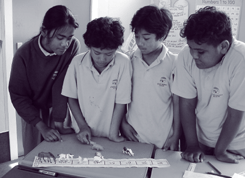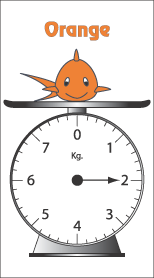New
Zealand’s National Education Monitoring Project commenced in
1993, with the task of assessing and reporting on the achievement
of NewZealand primary school children in all areas of the school
curriculum. Children are assessed at two class levels: Year 4 (halfway
through primary education) and Year 8 (at the end of primary education).
Different curriculum areas and skills are assessed each year, over
a four year cycle. The main goal of national monitoring is to provide
detailed information about what children can do so that patterns
of performance can be recognised, successes celebrated, and desirable
changes to educational practices and resources identified and implemented.
Each year, small random samples of children are selected nationally,
then assessed in their own schools by teachers specially seconded
and trained for this work. Task instructions are given orally by
teachers, through video presentations, on laptop computers, or in
writing. Many of the assessment tasks involve the children in the
use of equipment and supplies. Their responses are presented orally,
by demonstration, in writing, in computer files, or through submission
of other physical products. Many of the responses are recorded on
videotape for subsequent analysis.
The use of many tasks with both year 4 and year 8 students allows
comparisons of the performance of year 4 and 8 students in 2001.
Because some tasks have been used twice, in 1997 and again in 2001,
trends in performance across the four year period can also be analysed.
In 2001, the third year of the second cycle of national monitoring,
three areas were assessed: mathematics, social studies, and information
skills. This report presents details and results of the mathematics
assessments.
Assessing
Mathematics
Chapter 2 explains the
place of mathematics in the New Zealand curriculum and presents
the mathematics framework. It identifies five areas of knowledge
or curriculum strands (number, measurement, geometry, algebra, and
statistics), linked to five major processes and skills. The importance
of attitudes and motivation is also highlighted. The assessment
results are arranged in chapters according to the strands in the
curriculum, but with algebra and statistics in one chapter because
of small numbers of tasks in these two areas and also space constraints
in this report.
Number Chapter
3 presents the students’ results on 35 number tasks. Averaged
across 229 task components administered to both year 4 and year
8 students, 25 percent more year 8 than year 4 students succeeded
with these components. Year 8 students performed better on every
component. As expected, the differences were generally larger on
more difficult tasks. These often were tasks that many year 4 students
would not yet have had much opportunity to learn in school.
There was evidence of modest improvement between 1997 and 2001,
especially for year 4 students. Averaged across 59 trend task components
attempted by year 4 students in both years, 5 percent more students
succeeded in 2001 than in 1997. Gains occurred on 51 of the 59 components.
At year 8 level, with 106 trend task components included, 3 percent
more students succeeded in 2001 than in 1997. Gains occurred on
85 of the 106 components.
Students at both levels scored poorly in tasks involving estimation
and tasks involving fractions (especially fractions other than halves
and quarters). Asked to work on computations such as 36 + 29 or
9 x 98, few students at both levels chose the simplification of
adjusting one of the numbers to a more easily handled adjacent number
(making the 29 into 30, or the 98 into 100). Most relied instead
on the standard algorithms for these tasks, indicating a lack of
deep understanding of number operations.
Measurement
Chapter 4 presents results
for 33 measurement tasks. Averaged across 101 task components administered
to both year 4 and year 8 students, 25 percent more year 8 than
year 4 students succeeded with these components. Year 8 students
performed better on 95 of the 101 components.
There was little evidence of change between 1997 and 2001. Averaged
across 41 trend task components attempted by year 4 students in
both years, 2 percent more students succeeded in 2001 than in 1997.
Gains occurred on 25 of the 41 components. At year 8 level, with
45 trend task components included, 2 percent fewer students succeeded
in 2001 than in 1997. Gains occurred on 15 of the 45 components.
At both levels, students were much more successful at making or
reading measurements than at making good estimates of measurements.
Also, many who could measure satisfactorily were not able to explain
clearly their processes and strategies for making and checking their
measurements.
Geometry Chapter
5 presents results for sixteen geometry tasks. Averaged across
41 task components administered to both year 4 and year 8 students,
23 percent more year 8 than year 4 students succeeded with these
components. Year 8 students performed better on all components.
There was little evidence of change between 1997 and 2001 for year
4 students, but a small decline for year 8 students. Averaged across
13 trend task components attempted by year 4 students in both years,
2 percent more students succeeded in 2001 than in 1997. Gains occurred
on 10 of the 13 components. At year 8 level, with 22 trend task
components included, 5 percent fewer students succeeded in 2001
than in 1997. Gains occurred on 3 of the 22 components.
Many students were able to identify the nets of three-dimensional
objects and to mirror a shape in a line of symmetry. Students had
less success with visualising the internal structure and cross sections
of three-dimensional objects, and with other spatial relationships
tasks in three dimensions.
Algebra and Statistics Chapter
6 presents results for ten algebra tasks and seven statistics
tasks. Averaged across 36 task components administered to both year
4 and year 8 students, 28 percent more year 8 than year 4 students
succeeded with these components. Year 8 students performed better
on 35 of the 36 components.
There was evidence of substantial improvement between 1997 and 2001
for year 4 students, but little change over the same period for
year 8 students. Averaged across 15 trend task components attempted
by year 4 students in both years, 9 percent more students succeeded
in 2001 than in 1997. Gains occurred on 14 of the 15 components.
At year 8 level, with 28 trend task components included, 1 percent
more students succeeded in 2001 than in 1997. Gains occurred on
16 of the 28 components.
Mathematics Surveys Chapter
7 focuses on the results of a survey that sought information
from students about their strategies for, involvement in, and enjoyment
of mathematics. Mathematics was the third most popular option for
year 4 students and the fourth most popular option for year 8 students.
At year 4 level its popularity remained constant between 1997 and
2001, but at year 8 level it was chosen by 9 percent fewer students
in 2001, while technology and art gained substantially from the
1997 results.
The students’ responses to eleven rating items showed the pattern
found to date in all subjects except technology; year 8 students
are less likely to use the most positive rating than year 4 students.
In other words, students become more cautious about expressing high
enthusiasm and self-confidence over the four additional years of
schooling.
Between 1997 and 2001, fewer students at both year levels said that
they didn’t know how good their teacher thought they were at
maths. This is a worthwhile improvement. A higher proportion of
students at both levels believed that their teachers and parents
thought that they were good at mathematics. The results for several
of the rating items suggested that student enthusiasm for mathematics
was static or declined slightly over the four year period.
Performance of subgroups Chapter
8 details the results of analyses comparing the performance
of different demographic subgroups. Statistically significant differences
of task performance among the subgroups based on school size, school
type or community size occurred for very few tasks. There were differences
among the three geographic zone subgroups on 15 percent of the tasks
for year 4 students, but only 2 percent of the tasks for year 8
students. Boys performed better than girls on 12 percent of the
year 4 tasks and 5 percent of the year 8 tasks, but girls performed
better than boys on 2 percent of the year 8 tasks. Non-Mäori
students performed better than Mäori students on 75 percent
of the year 4 tasks and 66 percent of the year 8 tasks. The SES
index based on school deciles showed the strongest pattern of differences,
with differences on 87 percent of the year 4 tasks and 76 percent
of the year 8 tasks.
The 2001 results for the Mäori/Non-Mäori and SES (school
decile) comparisons are very similar to the corresponding 1997 results.
In 1997 there were Mäori/Non-Mäori differences on 80 percent
of year 4 tasks and 77 percent of year 8 tasks, and school decile
differences on 85 percent of year 4 tasks and 77 percent of year
8 tasks. The most noticeable, although still relatively small, changes
from the 1997 results involve the gains of boys relative to girls.
In 2001, year 4 boys performed better than girls on 12 percent of
tasks (2 percent in 1997) and worse on none (4 percent in 1997).
Year 8 boys performed better than girls on 5 percent of tasks (2
percent in 1997) and worse on 2 percent (14 percent in 1997).
Pacific subgroups Chapter
9 reports the results of analyses of the achievement of Pacific
Island students. Additional sampling of schools with high proportions
of Pacific Island students permitted comparison of the achievement
of Pacific Island, Mäori and other children attending schools
that have more than 15 percent Pacific Island students enrolled.
The results apply only to such schools, but it should be noted that
about 75 percent of all Pacific students attend schools in this
category.
Year 4 Pacific students performed similarly to their Mäori
peers, but less well than “other” students on 45 percent
of the tasks. Year 8 Pacific students performed similarly to their
Mäori peers, but less well than “other” students
on 27 percent of the tasks.


